An Analysis of People Management Problems in Tour Operations
VerifiedAdded on 2022/12/30
|12
|2643
|25
Report
AI Summary
This report analyzes people management challenges within the tour operating industry, using De Havilland Holidays as a case study. It identifies key issues such as low revenue growth, high turnover rates among graduate trainees and managers, and employee satisfaction problems. The report explores contributing factors to these issues, including the impact of the 2008 financial crisis and increasing competition. It discusses the importance of effective people management strategies, including employee engagement, motivation, and retention. The report applies Herzberg's two-factor model to understand the relationship between hygiene and motivational factors and employee satisfaction. It highlights the need for improved recruitment processes, training and development programs, and competitive benefits packages to address attrition and enhance overall performance. The report concludes with a summary of the findings and recommendations for improving people management practices within tour operating companies.
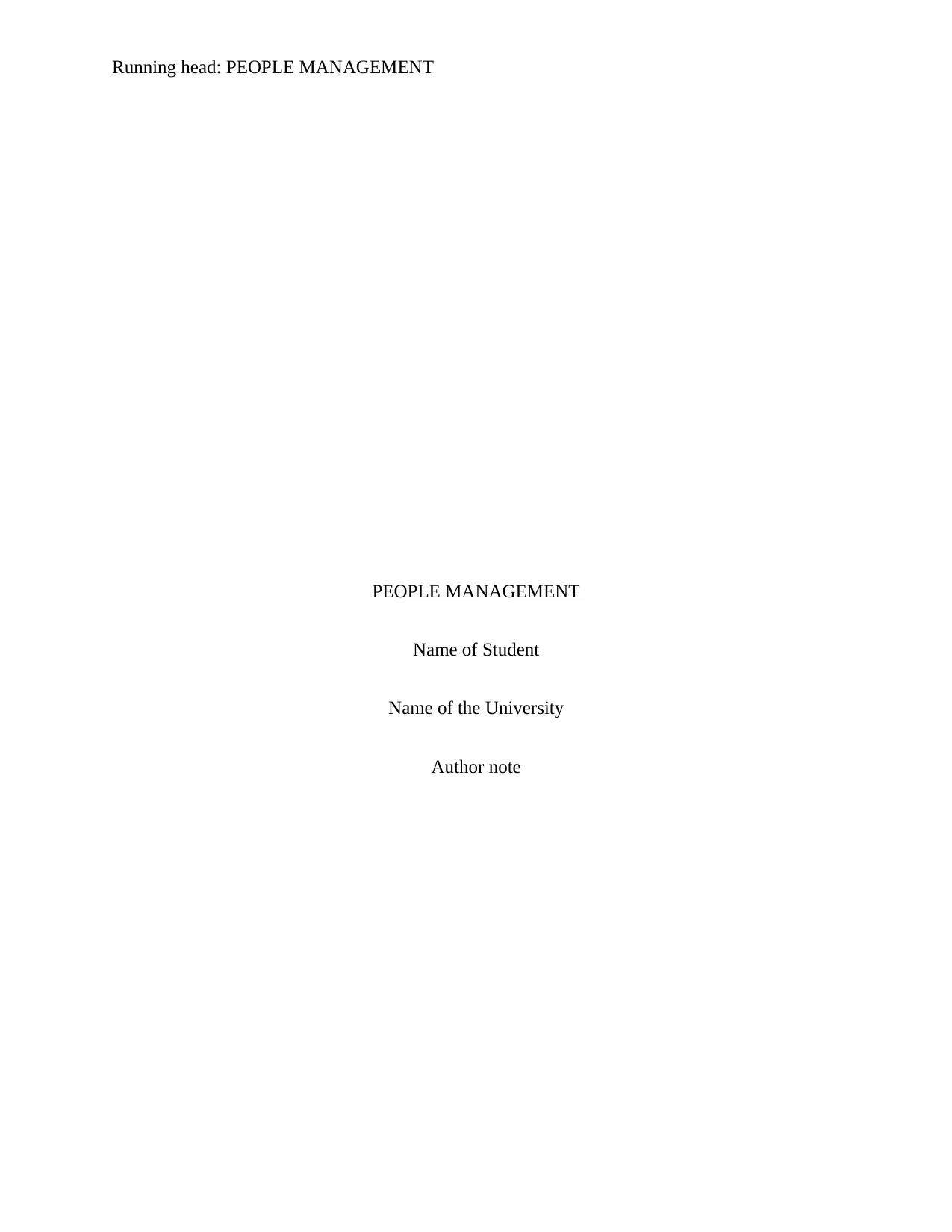
Running head: PEOPLE MANAGEMENT
PEOPLE MANAGEMENT
Name of Student
Name of the University
Author note
PEOPLE MANAGEMENT
Name of Student
Name of the University
Author note
Paraphrase This Document
Need a fresh take? Get an instant paraphrase of this document with our AI Paraphraser
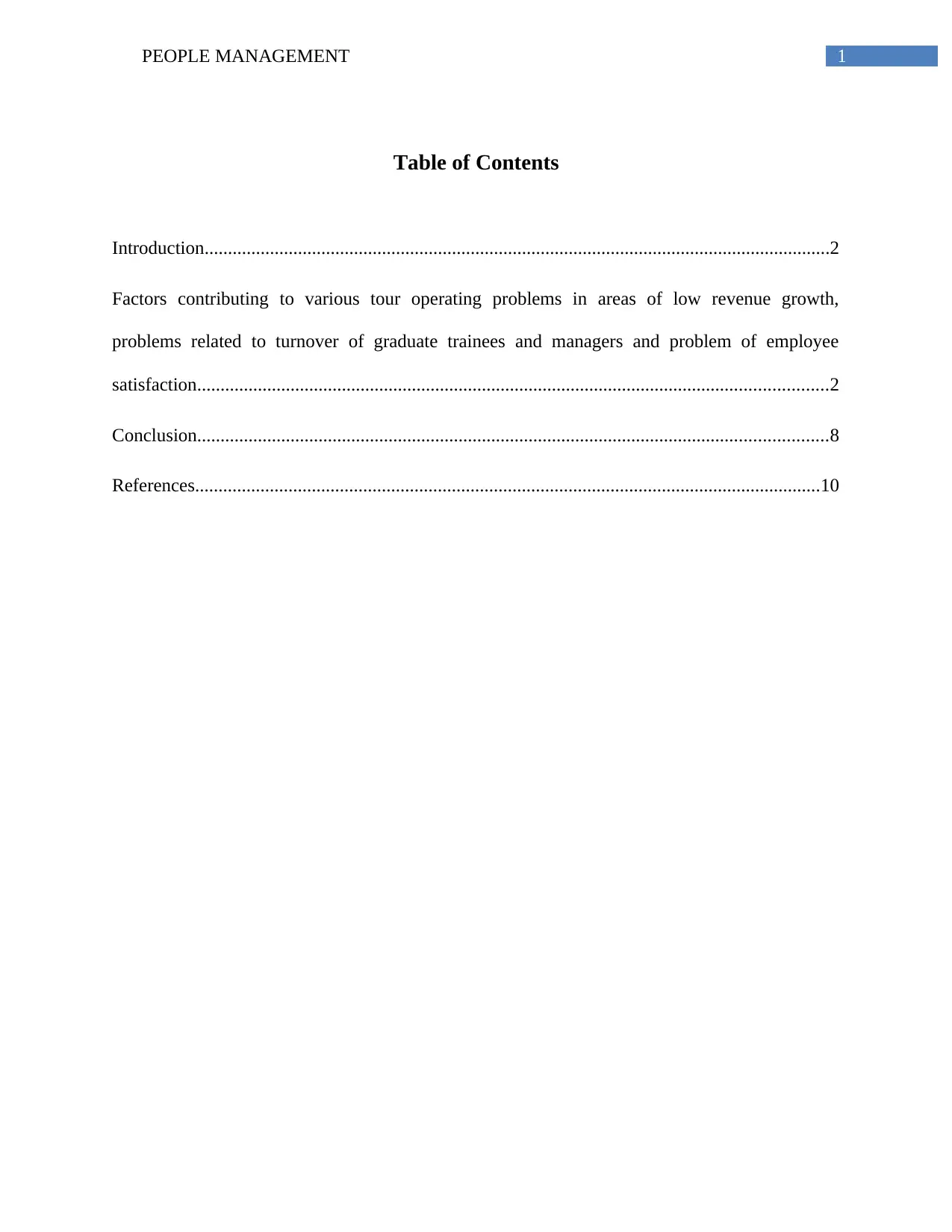
1PEOPLE MANAGEMENT
Table of Contents
Introduction......................................................................................................................................2
Factors contributing to various tour operating problems in areas of low revenue growth,
problems related to turnover of graduate trainees and managers and problem of employee
satisfaction.......................................................................................................................................2
Conclusion.......................................................................................................................................8
References......................................................................................................................................10
Table of Contents
Introduction......................................................................................................................................2
Factors contributing to various tour operating problems in areas of low revenue growth,
problems related to turnover of graduate trainees and managers and problem of employee
satisfaction.......................................................................................................................................2
Conclusion.......................................................................................................................................8
References......................................................................................................................................10
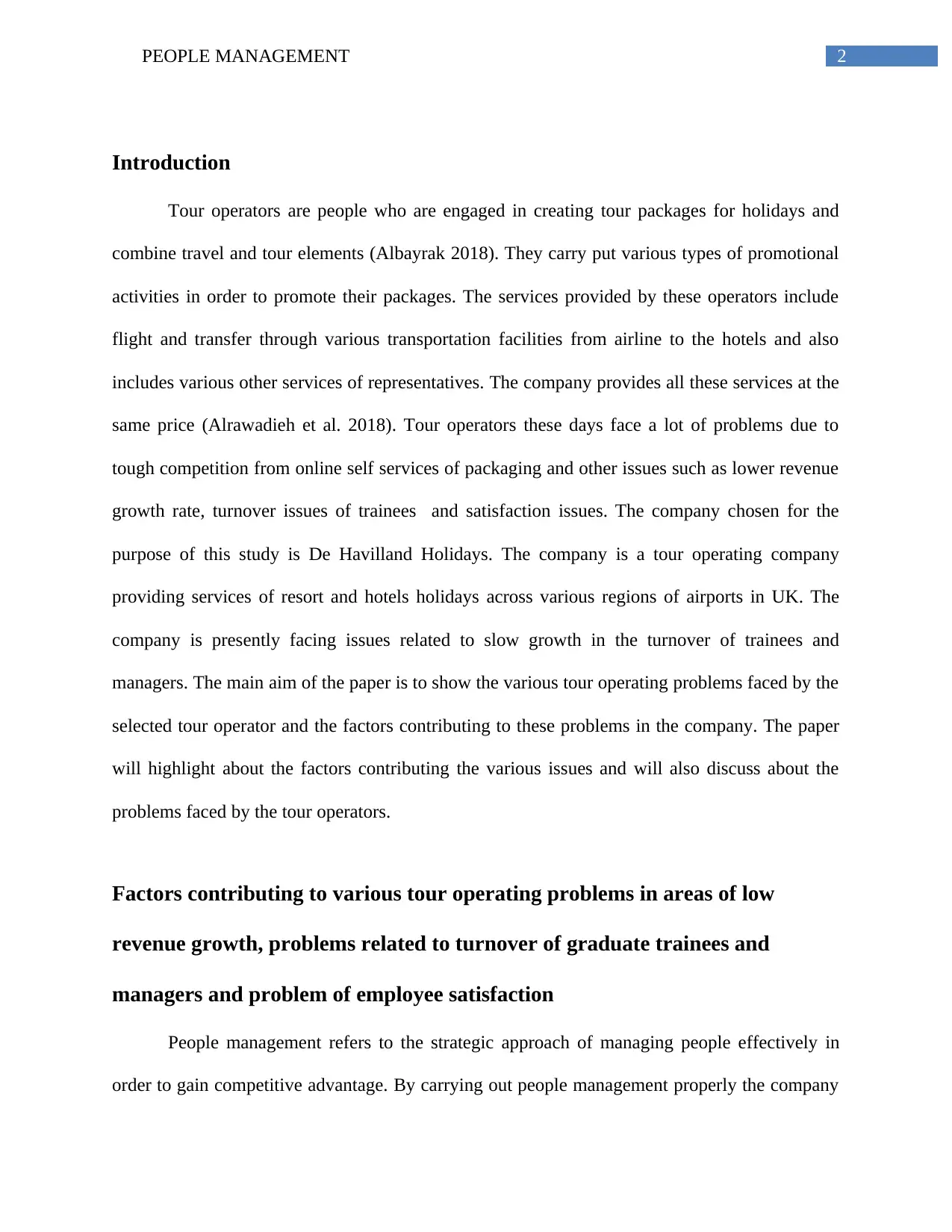
2PEOPLE MANAGEMENT
Introduction
Tour operators are people who are engaged in creating tour packages for holidays and
combine travel and tour elements (Albayrak 2018). They carry put various types of promotional
activities in order to promote their packages. The services provided by these operators include
flight and transfer through various transportation facilities from airline to the hotels and also
includes various other services of representatives. The company provides all these services at the
same price (Alrawadieh et al. 2018). Tour operators these days face a lot of problems due to
tough competition from online self services of packaging and other issues such as lower revenue
growth rate, turnover issues of trainees and satisfaction issues. The company chosen for the
purpose of this study is De Havilland Holidays. The company is a tour operating company
providing services of resort and hotels holidays across various regions of airports in UK. The
company is presently facing issues related to slow growth in the turnover of trainees and
managers. The main aim of the paper is to show the various tour operating problems faced by the
selected tour operator and the factors contributing to these problems in the company. The paper
will highlight about the factors contributing the various issues and will also discuss about the
problems faced by the tour operators.
Factors contributing to various tour operating problems in areas of low
revenue growth, problems related to turnover of graduate trainees and
managers and problem of employee satisfaction
People management refers to the strategic approach of managing people effectively in
order to gain competitive advantage. By carrying out people management properly the company
Introduction
Tour operators are people who are engaged in creating tour packages for holidays and
combine travel and tour elements (Albayrak 2018). They carry put various types of promotional
activities in order to promote their packages. The services provided by these operators include
flight and transfer through various transportation facilities from airline to the hotels and also
includes various other services of representatives. The company provides all these services at the
same price (Alrawadieh et al. 2018). Tour operators these days face a lot of problems due to
tough competition from online self services of packaging and other issues such as lower revenue
growth rate, turnover issues of trainees and satisfaction issues. The company chosen for the
purpose of this study is De Havilland Holidays. The company is a tour operating company
providing services of resort and hotels holidays across various regions of airports in UK. The
company is presently facing issues related to slow growth in the turnover of trainees and
managers. The main aim of the paper is to show the various tour operating problems faced by the
selected tour operator and the factors contributing to these problems in the company. The paper
will highlight about the factors contributing the various issues and will also discuss about the
problems faced by the tour operators.
Factors contributing to various tour operating problems in areas of low
revenue growth, problems related to turnover of graduate trainees and
managers and problem of employee satisfaction
People management refers to the strategic approach of managing people effectively in
order to gain competitive advantage. By carrying out people management properly the company
⊘ This is a preview!⊘
Do you want full access?
Subscribe today to unlock all pages.

Trusted by 1+ million students worldwide
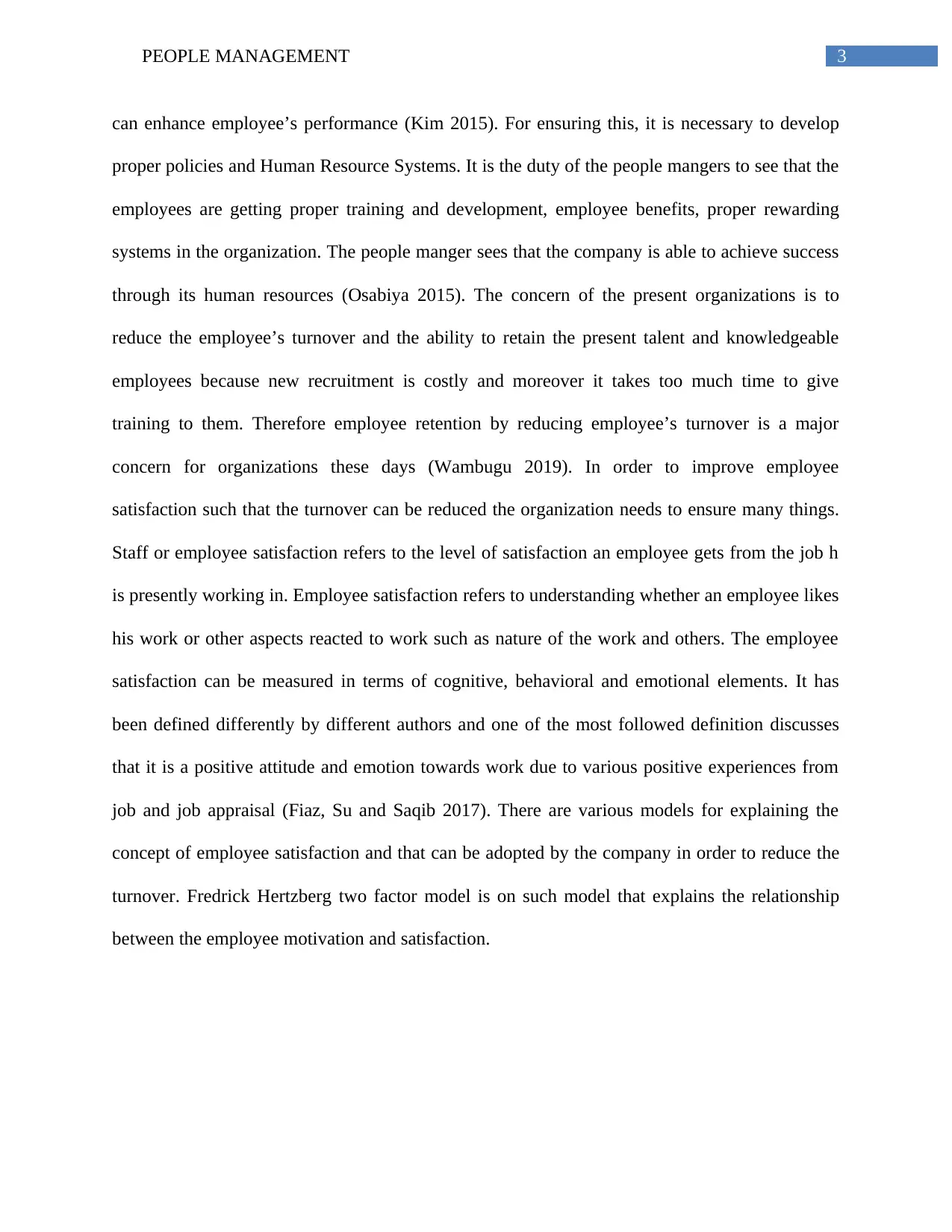
3PEOPLE MANAGEMENT
can enhance employee’s performance (Kim 2015). For ensuring this, it is necessary to develop
proper policies and Human Resource Systems. It is the duty of the people mangers to see that the
employees are getting proper training and development, employee benefits, proper rewarding
systems in the organization. The people manger sees that the company is able to achieve success
through its human resources (Osabiya 2015). The concern of the present organizations is to
reduce the employee’s turnover and the ability to retain the present talent and knowledgeable
employees because new recruitment is costly and moreover it takes too much time to give
training to them. Therefore employee retention by reducing employee’s turnover is a major
concern for organizations these days (Wambugu 2019). In order to improve employee
satisfaction such that the turnover can be reduced the organization needs to ensure many things.
Staff or employee satisfaction refers to the level of satisfaction an employee gets from the job h
is presently working in. Employee satisfaction refers to understanding whether an employee likes
his work or other aspects reacted to work such as nature of the work and others. The employee
satisfaction can be measured in terms of cognitive, behavioral and emotional elements. It has
been defined differently by different authors and one of the most followed definition discusses
that it is a positive attitude and emotion towards work due to various positive experiences from
job and job appraisal (Fiaz, Su and Saqib 2017). There are various models for explaining the
concept of employee satisfaction and that can be adopted by the company in order to reduce the
turnover. Fredrick Hertzberg two factor model is on such model that explains the relationship
between the employee motivation and satisfaction.
can enhance employee’s performance (Kim 2015). For ensuring this, it is necessary to develop
proper policies and Human Resource Systems. It is the duty of the people mangers to see that the
employees are getting proper training and development, employee benefits, proper rewarding
systems in the organization. The people manger sees that the company is able to achieve success
through its human resources (Osabiya 2015). The concern of the present organizations is to
reduce the employee’s turnover and the ability to retain the present talent and knowledgeable
employees because new recruitment is costly and moreover it takes too much time to give
training to them. Therefore employee retention by reducing employee’s turnover is a major
concern for organizations these days (Wambugu 2019). In order to improve employee
satisfaction such that the turnover can be reduced the organization needs to ensure many things.
Staff or employee satisfaction refers to the level of satisfaction an employee gets from the job h
is presently working in. Employee satisfaction refers to understanding whether an employee likes
his work or other aspects reacted to work such as nature of the work and others. The employee
satisfaction can be measured in terms of cognitive, behavioral and emotional elements. It has
been defined differently by different authors and one of the most followed definition discusses
that it is a positive attitude and emotion towards work due to various positive experiences from
job and job appraisal (Fiaz, Su and Saqib 2017). There are various models for explaining the
concept of employee satisfaction and that can be adopted by the company in order to reduce the
turnover. Fredrick Hertzberg two factor model is on such model that explains the relationship
between the employee motivation and satisfaction.
Paraphrase This Document
Need a fresh take? Get an instant paraphrase of this document with our AI Paraphraser
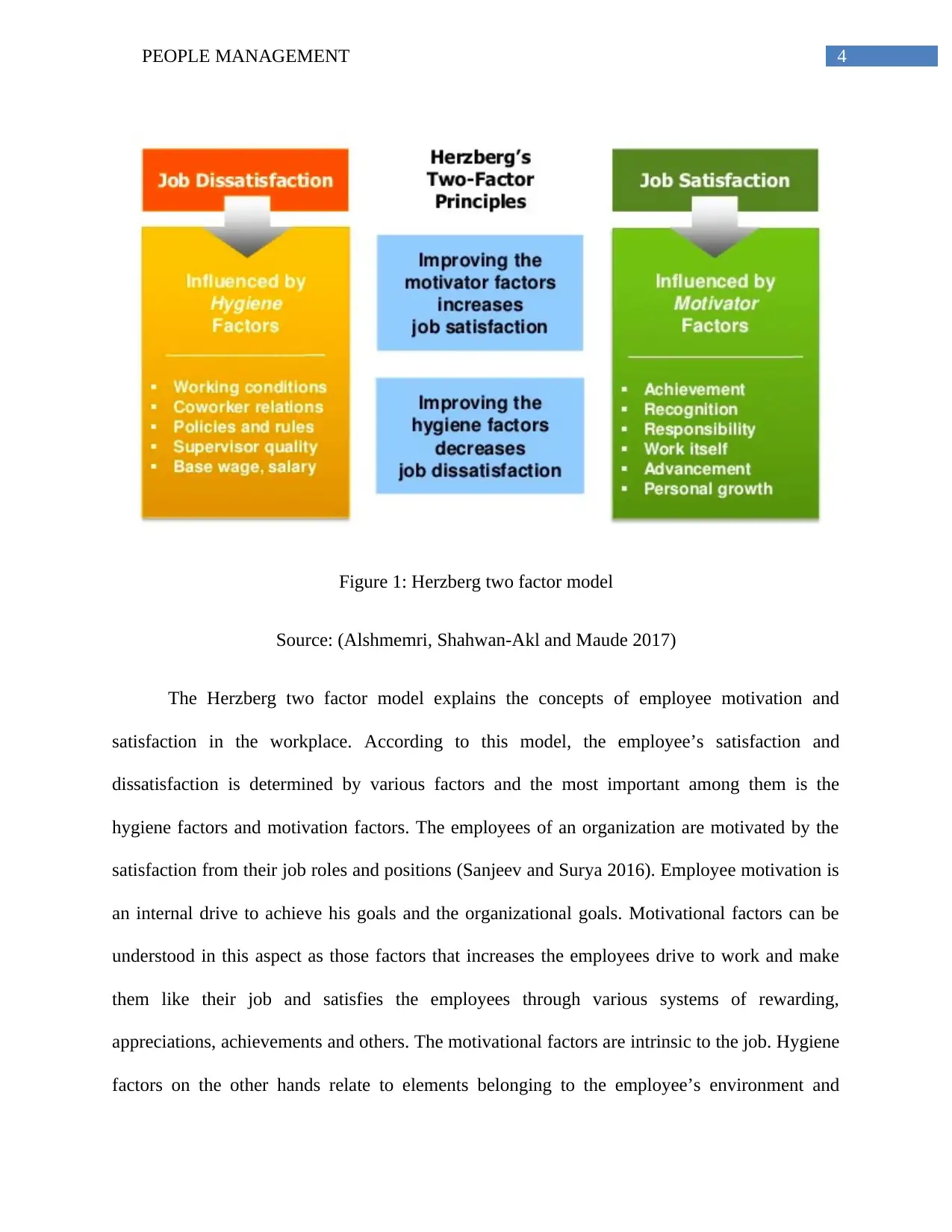
4PEOPLE MANAGEMENT
Figure 1: Herzberg two factor model
Source: (Alshmemri, Shahwan-Akl and Maude 2017)
The Herzberg two factor model explains the concepts of employee motivation and
satisfaction in the workplace. According to this model, the employee’s satisfaction and
dissatisfaction is determined by various factors and the most important among them is the
hygiene factors and motivation factors. The employees of an organization are motivated by the
satisfaction from their job roles and positions (Sanjeev and Surya 2016). Employee motivation is
an internal drive to achieve his goals and the organizational goals. Motivational factors can be
understood in this aspect as those factors that increases the employees drive to work and make
them like their job and satisfies the employees through various systems of rewarding,
appreciations, achievements and others. The motivational factors are intrinsic to the job. Hygiene
factors on the other hands relate to elements belonging to the employee’s environment and
Figure 1: Herzberg two factor model
Source: (Alshmemri, Shahwan-Akl and Maude 2017)
The Herzberg two factor model explains the concepts of employee motivation and
satisfaction in the workplace. According to this model, the employee’s satisfaction and
dissatisfaction is determined by various factors and the most important among them is the
hygiene factors and motivation factors. The employees of an organization are motivated by the
satisfaction from their job roles and positions (Sanjeev and Surya 2016). Employee motivation is
an internal drive to achieve his goals and the organizational goals. Motivational factors can be
understood in this aspect as those factors that increases the employees drive to work and make
them like their job and satisfies the employees through various systems of rewarding,
appreciations, achievements and others. The motivational factors are intrinsic to the job. Hygiene
factors on the other hands relate to elements belonging to the employee’s environment and
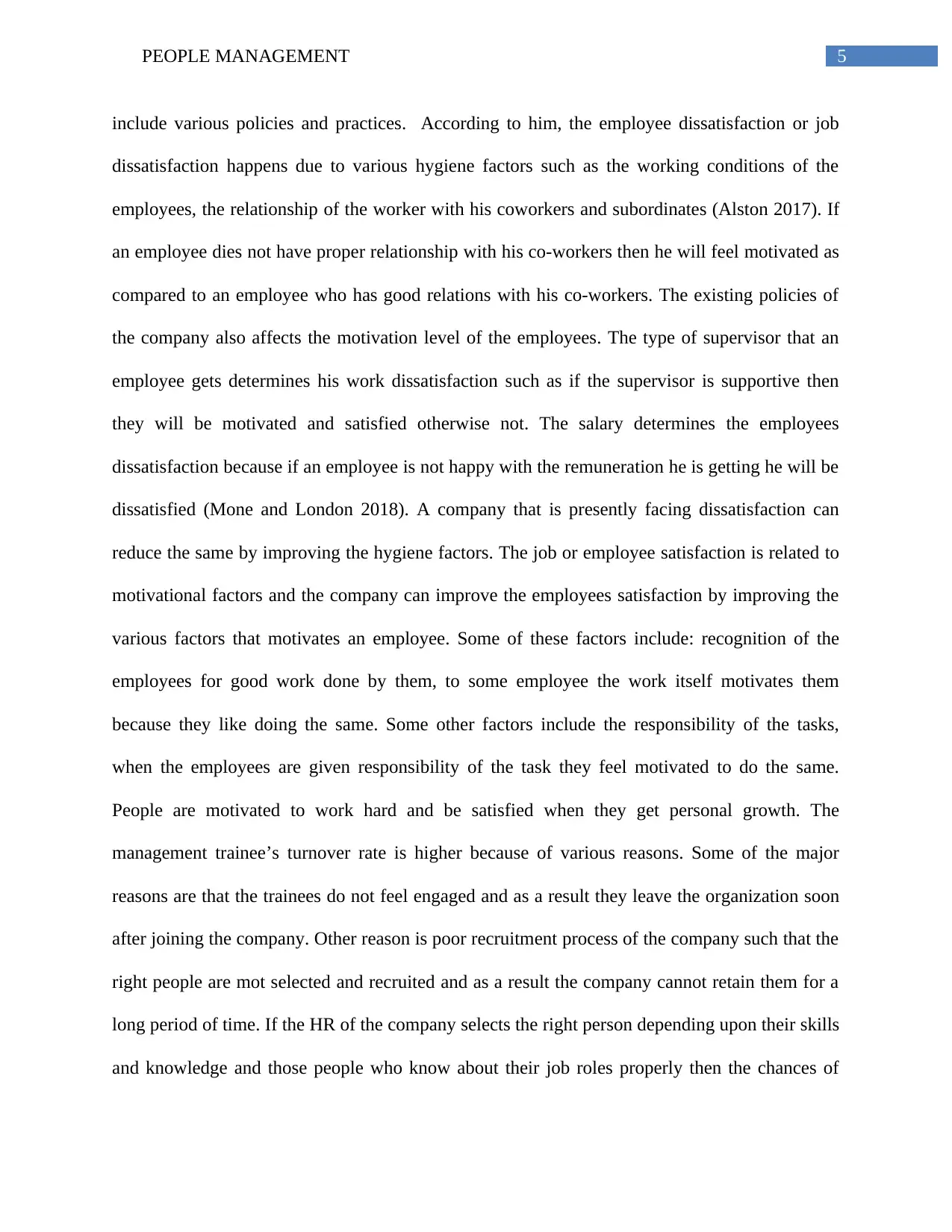
5PEOPLE MANAGEMENT
include various policies and practices. According to him, the employee dissatisfaction or job
dissatisfaction happens due to various hygiene factors such as the working conditions of the
employees, the relationship of the worker with his coworkers and subordinates (Alston 2017). If
an employee dies not have proper relationship with his co-workers then he will feel motivated as
compared to an employee who has good relations with his co-workers. The existing policies of
the company also affects the motivation level of the employees. The type of supervisor that an
employee gets determines his work dissatisfaction such as if the supervisor is supportive then
they will be motivated and satisfied otherwise not. The salary determines the employees
dissatisfaction because if an employee is not happy with the remuneration he is getting he will be
dissatisfied (Mone and London 2018). A company that is presently facing dissatisfaction can
reduce the same by improving the hygiene factors. The job or employee satisfaction is related to
motivational factors and the company can improve the employees satisfaction by improving the
various factors that motivates an employee. Some of these factors include: recognition of the
employees for good work done by them, to some employee the work itself motivates them
because they like doing the same. Some other factors include the responsibility of the tasks,
when the employees are given responsibility of the task they feel motivated to do the same.
People are motivated to work hard and be satisfied when they get personal growth. The
management trainee’s turnover rate is higher because of various reasons. Some of the major
reasons are that the trainees do not feel engaged and as a result they leave the organization soon
after joining the company. Other reason is poor recruitment process of the company such that the
right people are mot selected and recruited and as a result the company cannot retain them for a
long period of time. If the HR of the company selects the right person depending upon their skills
and knowledge and those people who know about their job roles properly then the chances of
include various policies and practices. According to him, the employee dissatisfaction or job
dissatisfaction happens due to various hygiene factors such as the working conditions of the
employees, the relationship of the worker with his coworkers and subordinates (Alston 2017). If
an employee dies not have proper relationship with his co-workers then he will feel motivated as
compared to an employee who has good relations with his co-workers. The existing policies of
the company also affects the motivation level of the employees. The type of supervisor that an
employee gets determines his work dissatisfaction such as if the supervisor is supportive then
they will be motivated and satisfied otherwise not. The salary determines the employees
dissatisfaction because if an employee is not happy with the remuneration he is getting he will be
dissatisfied (Mone and London 2018). A company that is presently facing dissatisfaction can
reduce the same by improving the hygiene factors. The job or employee satisfaction is related to
motivational factors and the company can improve the employees satisfaction by improving the
various factors that motivates an employee. Some of these factors include: recognition of the
employees for good work done by them, to some employee the work itself motivates them
because they like doing the same. Some other factors include the responsibility of the tasks,
when the employees are given responsibility of the task they feel motivated to do the same.
People are motivated to work hard and be satisfied when they get personal growth. The
management trainee’s turnover rate is higher because of various reasons. Some of the major
reasons are that the trainees do not feel engaged and as a result they leave the organization soon
after joining the company. Other reason is poor recruitment process of the company such that the
right people are mot selected and recruited and as a result the company cannot retain them for a
long period of time. If the HR of the company selects the right person depending upon their skills
and knowledge and those people who know about their job roles properly then the chances of
⊘ This is a preview!⊘
Do you want full access?
Subscribe today to unlock all pages.

Trusted by 1+ million students worldwide
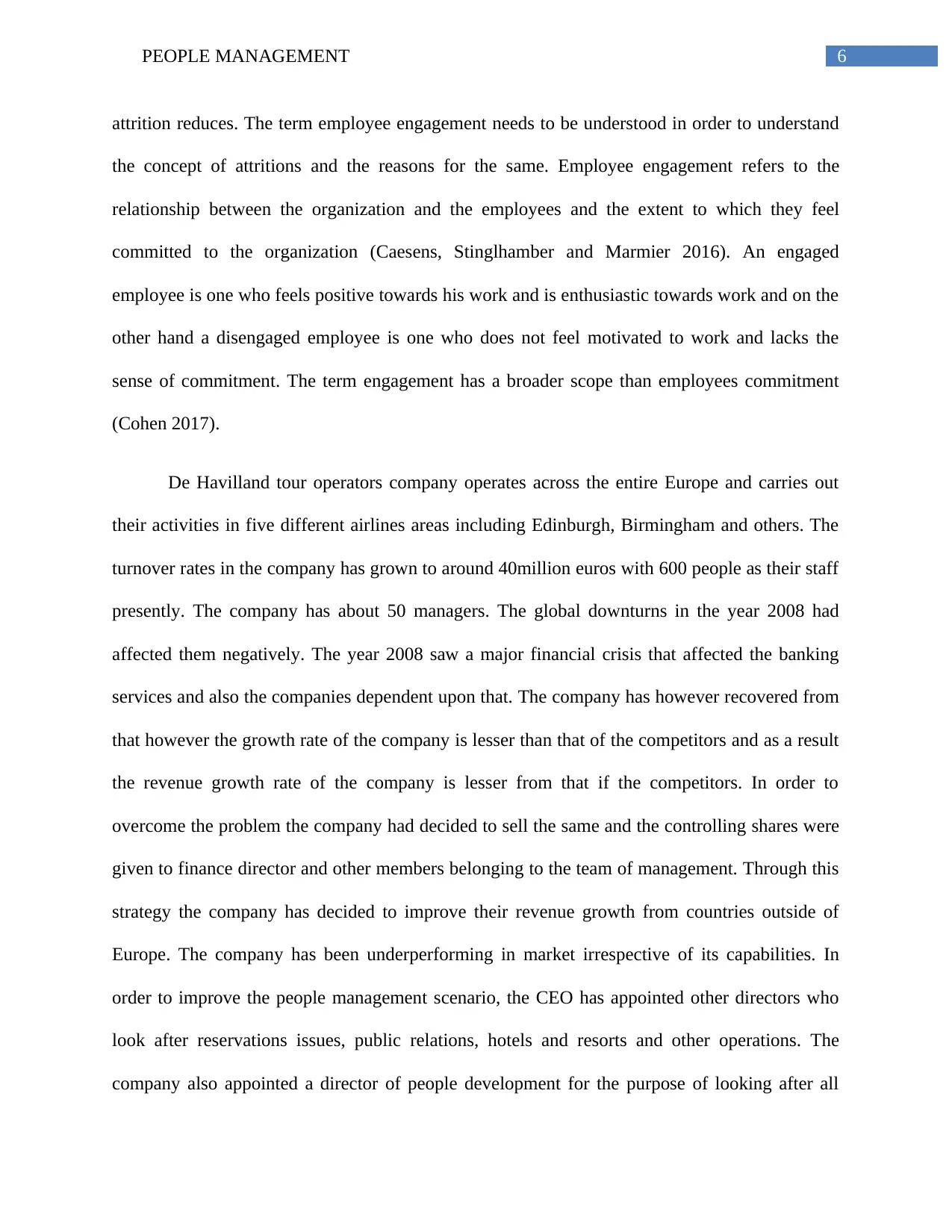
6PEOPLE MANAGEMENT
attrition reduces. The term employee engagement needs to be understood in order to understand
the concept of attritions and the reasons for the same. Employee engagement refers to the
relationship between the organization and the employees and the extent to which they feel
committed to the organization (Caesens, Stinglhamber and Marmier 2016). An engaged
employee is one who feels positive towards his work and is enthusiastic towards work and on the
other hand a disengaged employee is one who does not feel motivated to work and lacks the
sense of commitment. The term engagement has a broader scope than employees commitment
(Cohen 2017).
De Havilland tour operators company operates across the entire Europe and carries out
their activities in five different airlines areas including Edinburgh, Birmingham and others. The
turnover rates in the company has grown to around 40million euros with 600 people as their staff
presently. The company has about 50 managers. The global downturns in the year 2008 had
affected them negatively. The year 2008 saw a major financial crisis that affected the banking
services and also the companies dependent upon that. The company has however recovered from
that however the growth rate of the company is lesser than that of the competitors and as a result
the revenue growth rate of the company is lesser from that if the competitors. In order to
overcome the problem the company had decided to sell the same and the controlling shares were
given to finance director and other members belonging to the team of management. Through this
strategy the company has decided to improve their revenue growth from countries outside of
Europe. The company has been underperforming in market irrespective of its capabilities. In
order to improve the people management scenario, the CEO has appointed other directors who
look after reservations issues, public relations, hotels and resorts and other operations. The
company also appointed a director of people development for the purpose of looking after all
attrition reduces. The term employee engagement needs to be understood in order to understand
the concept of attritions and the reasons for the same. Employee engagement refers to the
relationship between the organization and the employees and the extent to which they feel
committed to the organization (Caesens, Stinglhamber and Marmier 2016). An engaged
employee is one who feels positive towards his work and is enthusiastic towards work and on the
other hand a disengaged employee is one who does not feel motivated to work and lacks the
sense of commitment. The term engagement has a broader scope than employees commitment
(Cohen 2017).
De Havilland tour operators company operates across the entire Europe and carries out
their activities in five different airlines areas including Edinburgh, Birmingham and others. The
turnover rates in the company has grown to around 40million euros with 600 people as their staff
presently. The company has about 50 managers. The global downturns in the year 2008 had
affected them negatively. The year 2008 saw a major financial crisis that affected the banking
services and also the companies dependent upon that. The company has however recovered from
that however the growth rate of the company is lesser than that of the competitors and as a result
the revenue growth rate of the company is lesser from that if the competitors. In order to
overcome the problem the company had decided to sell the same and the controlling shares were
given to finance director and other members belonging to the team of management. Through this
strategy the company has decided to improve their revenue growth from countries outside of
Europe. The company has been underperforming in market irrespective of its capabilities. In
order to improve the people management scenario, the CEO has appointed other directors who
look after reservations issues, public relations, hotels and resorts and other operations. The
company also appointed a director of people development for the purpose of looking after all
Paraphrase This Document
Need a fresh take? Get an instant paraphrase of this document with our AI Paraphraser
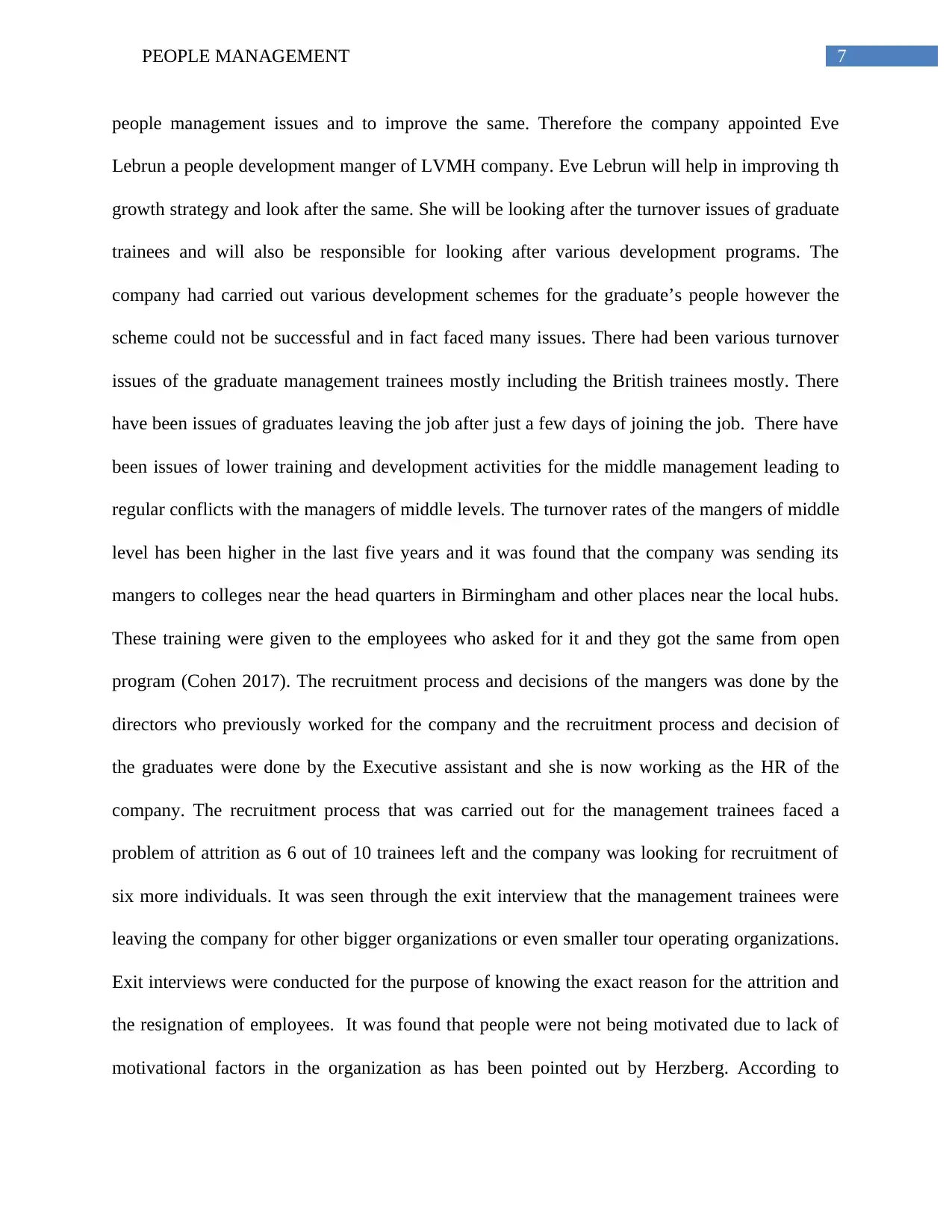
7PEOPLE MANAGEMENT
people management issues and to improve the same. Therefore the company appointed Eve
Lebrun a people development manger of LVMH company. Eve Lebrun will help in improving th
growth strategy and look after the same. She will be looking after the turnover issues of graduate
trainees and will also be responsible for looking after various development programs. The
company had carried out various development schemes for the graduate’s people however the
scheme could not be successful and in fact faced many issues. There had been various turnover
issues of the graduate management trainees mostly including the British trainees mostly. There
have been issues of graduates leaving the job after just a few days of joining the job. There have
been issues of lower training and development activities for the middle management leading to
regular conflicts with the managers of middle levels. The turnover rates of the mangers of middle
level has been higher in the last five years and it was found that the company was sending its
mangers to colleges near the head quarters in Birmingham and other places near the local hubs.
These training were given to the employees who asked for it and they got the same from open
program (Cohen 2017). The recruitment process and decisions of the mangers was done by the
directors who previously worked for the company and the recruitment process and decision of
the graduates were done by the Executive assistant and she is now working as the HR of the
company. The recruitment process that was carried out for the management trainees faced a
problem of attrition as 6 out of 10 trainees left and the company was looking for recruitment of
six more individuals. It was seen through the exit interview that the management trainees were
leaving the company for other bigger organizations or even smaller tour operating organizations.
Exit interviews were conducted for the purpose of knowing the exact reason for the attrition and
the resignation of employees. It was found that people were not being motivated due to lack of
motivational factors in the organization as has been pointed out by Herzberg. According to
people management issues and to improve the same. Therefore the company appointed Eve
Lebrun a people development manger of LVMH company. Eve Lebrun will help in improving th
growth strategy and look after the same. She will be looking after the turnover issues of graduate
trainees and will also be responsible for looking after various development programs. The
company had carried out various development schemes for the graduate’s people however the
scheme could not be successful and in fact faced many issues. There had been various turnover
issues of the graduate management trainees mostly including the British trainees mostly. There
have been issues of graduates leaving the job after just a few days of joining the job. There have
been issues of lower training and development activities for the middle management leading to
regular conflicts with the managers of middle levels. The turnover rates of the mangers of middle
level has been higher in the last five years and it was found that the company was sending its
mangers to colleges near the head quarters in Birmingham and other places near the local hubs.
These training were given to the employees who asked for it and they got the same from open
program (Cohen 2017). The recruitment process and decisions of the mangers was done by the
directors who previously worked for the company and the recruitment process and decision of
the graduates were done by the Executive assistant and she is now working as the HR of the
company. The recruitment process that was carried out for the management trainees faced a
problem of attrition as 6 out of 10 trainees left and the company was looking for recruitment of
six more individuals. It was seen through the exit interview that the management trainees were
leaving the company for other bigger organizations or even smaller tour operating organizations.
Exit interviews were conducted for the purpose of knowing the exact reason for the attrition and
the resignation of employees. It was found that people were not being motivated due to lack of
motivational factors in the organization as has been pointed out by Herzberg. According to
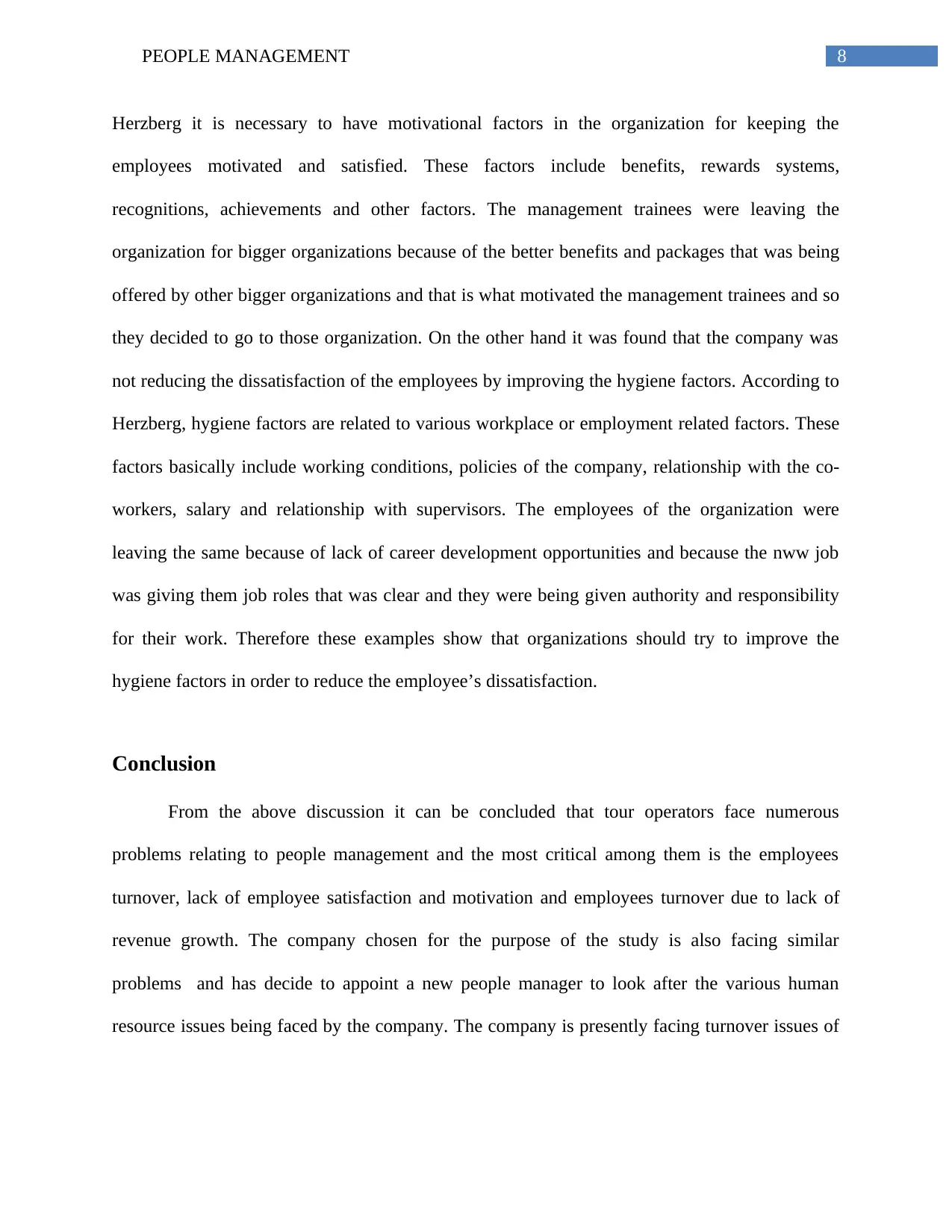
8PEOPLE MANAGEMENT
Herzberg it is necessary to have motivational factors in the organization for keeping the
employees motivated and satisfied. These factors include benefits, rewards systems,
recognitions, achievements and other factors. The management trainees were leaving the
organization for bigger organizations because of the better benefits and packages that was being
offered by other bigger organizations and that is what motivated the management trainees and so
they decided to go to those organization. On the other hand it was found that the company was
not reducing the dissatisfaction of the employees by improving the hygiene factors. According to
Herzberg, hygiene factors are related to various workplace or employment related factors. These
factors basically include working conditions, policies of the company, relationship with the co-
workers, salary and relationship with supervisors. The employees of the organization were
leaving the same because of lack of career development opportunities and because the nww job
was giving them job roles that was clear and they were being given authority and responsibility
for their work. Therefore these examples show that organizations should try to improve the
hygiene factors in order to reduce the employee’s dissatisfaction.
Conclusion
From the above discussion it can be concluded that tour operators face numerous
problems relating to people management and the most critical among them is the employees
turnover, lack of employee satisfaction and motivation and employees turnover due to lack of
revenue growth. The company chosen for the purpose of the study is also facing similar
problems and has decide to appoint a new people manager to look after the various human
resource issues being faced by the company. The company is presently facing turnover issues of
Herzberg it is necessary to have motivational factors in the organization for keeping the
employees motivated and satisfied. These factors include benefits, rewards systems,
recognitions, achievements and other factors. The management trainees were leaving the
organization for bigger organizations because of the better benefits and packages that was being
offered by other bigger organizations and that is what motivated the management trainees and so
they decided to go to those organization. On the other hand it was found that the company was
not reducing the dissatisfaction of the employees by improving the hygiene factors. According to
Herzberg, hygiene factors are related to various workplace or employment related factors. These
factors basically include working conditions, policies of the company, relationship with the co-
workers, salary and relationship with supervisors. The employees of the organization were
leaving the same because of lack of career development opportunities and because the nww job
was giving them job roles that was clear and they were being given authority and responsibility
for their work. Therefore these examples show that organizations should try to improve the
hygiene factors in order to reduce the employee’s dissatisfaction.
Conclusion
From the above discussion it can be concluded that tour operators face numerous
problems relating to people management and the most critical among them is the employees
turnover, lack of employee satisfaction and motivation and employees turnover due to lack of
revenue growth. The company chosen for the purpose of the study is also facing similar
problems and has decide to appoint a new people manager to look after the various human
resource issues being faced by the company. The company is presently facing turnover issues of
⊘ This is a preview!⊘
Do you want full access?
Subscribe today to unlock all pages.

Trusted by 1+ million students worldwide
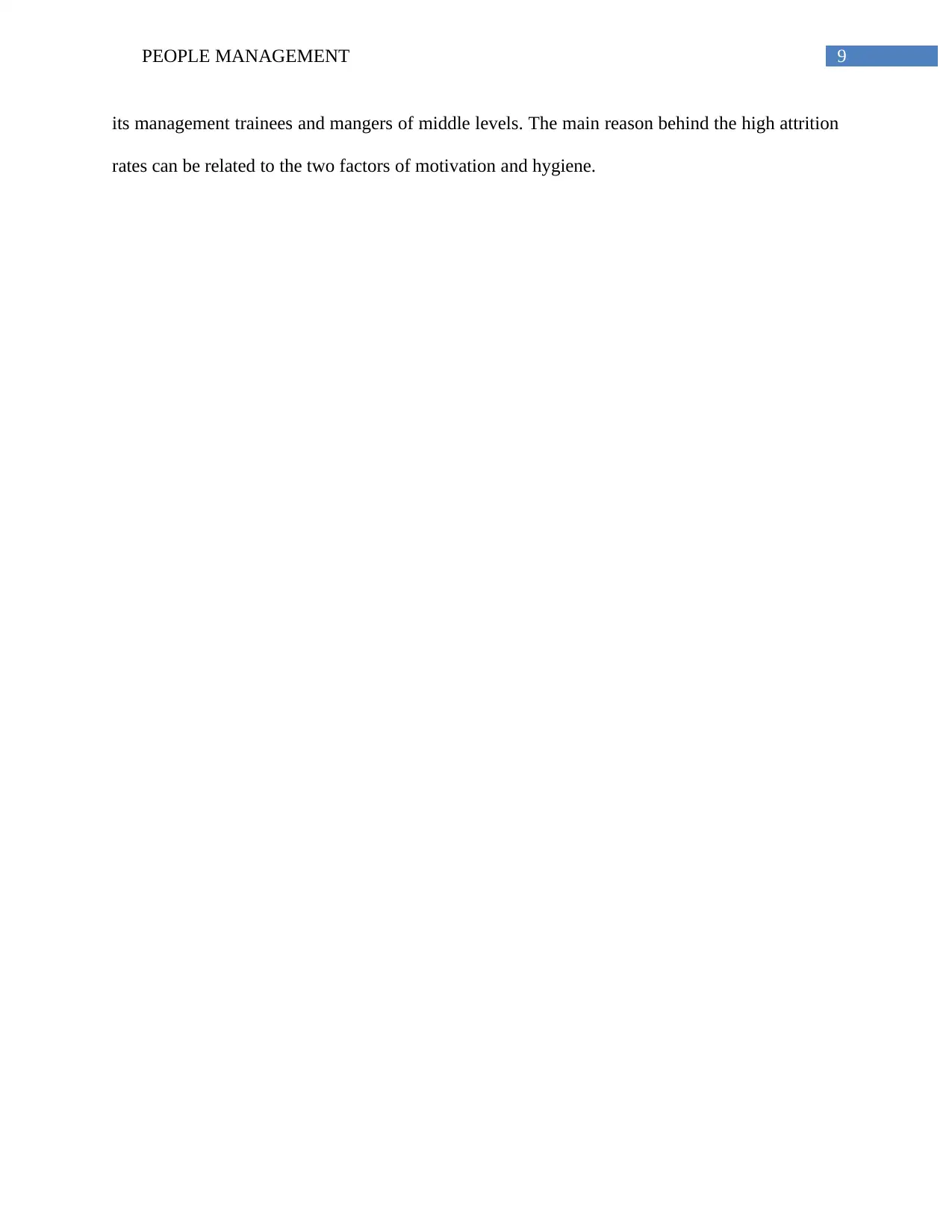
9PEOPLE MANAGEMENT
its management trainees and mangers of middle levels. The main reason behind the high attrition
rates can be related to the two factors of motivation and hygiene.
its management trainees and mangers of middle levels. The main reason behind the high attrition
rates can be related to the two factors of motivation and hygiene.
Paraphrase This Document
Need a fresh take? Get an instant paraphrase of this document with our AI Paraphraser
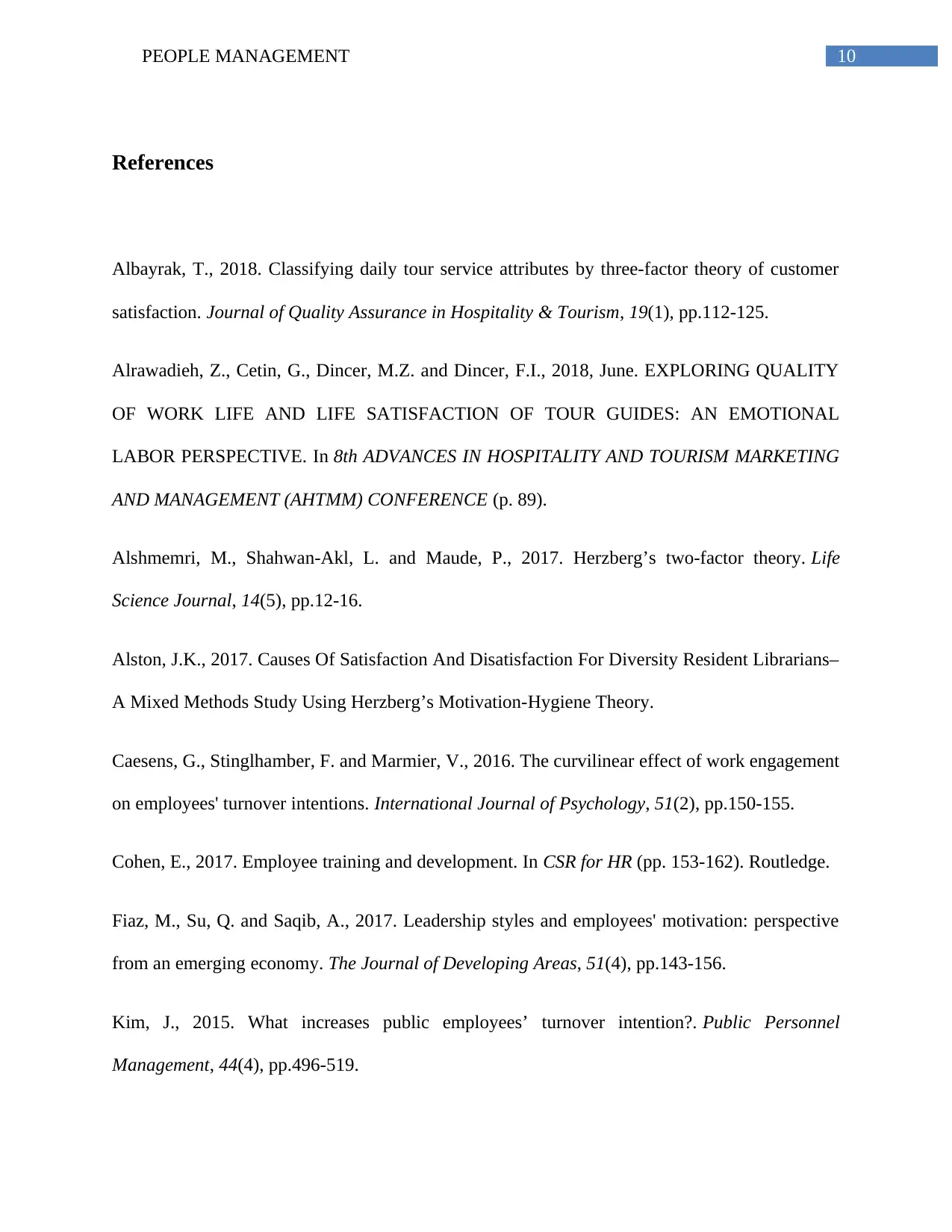
10PEOPLE MANAGEMENT
References
Albayrak, T., 2018. Classifying daily tour service attributes by three-factor theory of customer
satisfaction. Journal of Quality Assurance in Hospitality & Tourism, 19(1), pp.112-125.
Alrawadieh, Z., Cetin, G., Dincer, M.Z. and Dincer, F.I., 2018, June. EXPLORING QUALITY
OF WORK LIFE AND LIFE SATISFACTION OF TOUR GUIDES: AN EMOTIONAL
LABOR PERSPECTIVE. In 8th ADVANCES IN HOSPITALITY AND TOURISM MARKETING
AND MANAGEMENT (AHTMM) CONFERENCE (p. 89).
Alshmemri, M., Shahwan-Akl, L. and Maude, P., 2017. Herzberg’s two-factor theory. Life
Science Journal, 14(5), pp.12-16.
Alston, J.K., 2017. Causes Of Satisfaction And Disatisfaction For Diversity Resident Librarians–
A Mixed Methods Study Using Herzberg’s Motivation-Hygiene Theory.
Caesens, G., Stinglhamber, F. and Marmier, V., 2016. The curvilinear effect of work engagement
on employees' turnover intentions. International Journal of Psychology, 51(2), pp.150-155.
Cohen, E., 2017. Employee training and development. In CSR for HR (pp. 153-162). Routledge.
Fiaz, M., Su, Q. and Saqib, A., 2017. Leadership styles and employees' motivation: perspective
from an emerging economy. The Journal of Developing Areas, 51(4), pp.143-156.
Kim, J., 2015. What increases public employees’ turnover intention?. Public Personnel
Management, 44(4), pp.496-519.
References
Albayrak, T., 2018. Classifying daily tour service attributes by three-factor theory of customer
satisfaction. Journal of Quality Assurance in Hospitality & Tourism, 19(1), pp.112-125.
Alrawadieh, Z., Cetin, G., Dincer, M.Z. and Dincer, F.I., 2018, June. EXPLORING QUALITY
OF WORK LIFE AND LIFE SATISFACTION OF TOUR GUIDES: AN EMOTIONAL
LABOR PERSPECTIVE. In 8th ADVANCES IN HOSPITALITY AND TOURISM MARKETING
AND MANAGEMENT (AHTMM) CONFERENCE (p. 89).
Alshmemri, M., Shahwan-Akl, L. and Maude, P., 2017. Herzberg’s two-factor theory. Life
Science Journal, 14(5), pp.12-16.
Alston, J.K., 2017. Causes Of Satisfaction And Disatisfaction For Diversity Resident Librarians–
A Mixed Methods Study Using Herzberg’s Motivation-Hygiene Theory.
Caesens, G., Stinglhamber, F. and Marmier, V., 2016. The curvilinear effect of work engagement
on employees' turnover intentions. International Journal of Psychology, 51(2), pp.150-155.
Cohen, E., 2017. Employee training and development. In CSR for HR (pp. 153-162). Routledge.
Fiaz, M., Su, Q. and Saqib, A., 2017. Leadership styles and employees' motivation: perspective
from an emerging economy. The Journal of Developing Areas, 51(4), pp.143-156.
Kim, J., 2015. What increases public employees’ turnover intention?. Public Personnel
Management, 44(4), pp.496-519.
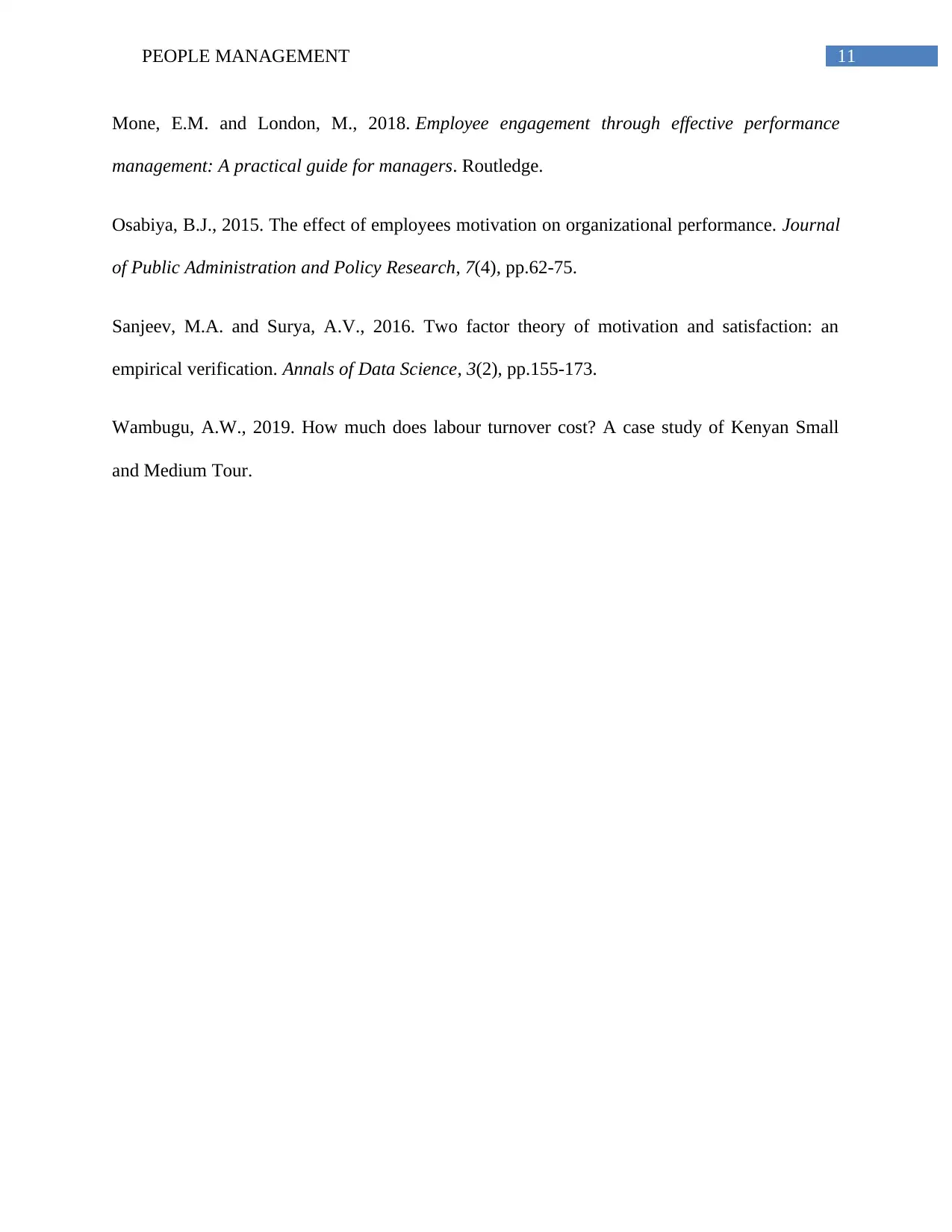
11PEOPLE MANAGEMENT
Mone, E.M. and London, M., 2018. Employee engagement through effective performance
management: A practical guide for managers. Routledge.
Osabiya, B.J., 2015. The effect of employees motivation on organizational performance. Journal
of Public Administration and Policy Research, 7(4), pp.62-75.
Sanjeev, M.A. and Surya, A.V., 2016. Two factor theory of motivation and satisfaction: an
empirical verification. Annals of Data Science, 3(2), pp.155-173.
Wambugu, A.W., 2019. How much does labour turnover cost? A case study of Kenyan Small
and Medium Tour.
Mone, E.M. and London, M., 2018. Employee engagement through effective performance
management: A practical guide for managers. Routledge.
Osabiya, B.J., 2015. The effect of employees motivation on organizational performance. Journal
of Public Administration and Policy Research, 7(4), pp.62-75.
Sanjeev, M.A. and Surya, A.V., 2016. Two factor theory of motivation and satisfaction: an
empirical verification. Annals of Data Science, 3(2), pp.155-173.
Wambugu, A.W., 2019. How much does labour turnover cost? A case study of Kenyan Small
and Medium Tour.
⊘ This is a preview!⊘
Do you want full access?
Subscribe today to unlock all pages.

Trusted by 1+ million students worldwide
1 out of 12
Related Documents
Your All-in-One AI-Powered Toolkit for Academic Success.
+13062052269
info@desklib.com
Available 24*7 on WhatsApp / Email
![[object Object]](/_next/static/media/star-bottom.7253800d.svg)
Unlock your academic potential
Copyright © 2020–2025 A2Z Services. All Rights Reserved. Developed and managed by ZUCOL.




